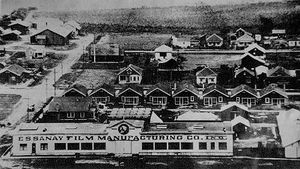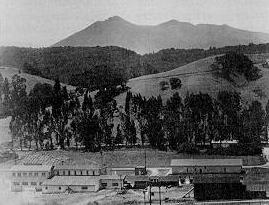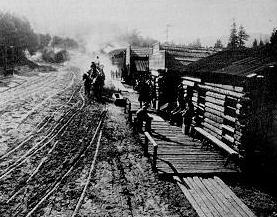Essanay Studios
The Essanay Film Manufacturing Company (also known as Essanay Studios) was an American motion picture studio founded in 1907 in the neighborhood of Uptown, Chicago, Illinois by George K. Spoor and Gilbert M. Anderson (Bronco Billy) , originally as the Peerless Film Manufacturing Company, but on August 10, 1907 changing the name to Essanay ("S and A"). It is best known today for its series of Charlie Chaplin comedies of 1915.
Essanay was originally located at 496 Wells Street (modern numbering: 1300 N. Wells). Essanay's first film, An Awful Skate, or The Hobo on Rollers (July 1907), starring Ben Turpin (then the studio janitor), produced for only a couple hundred dollars, grossed several thousand dollars in release. The studio prospered and in 1908 moved to its more famous address at 1333-45 W. Argyle St, Chicago IL.
Essanay produced silent films with such stars (and stars of the future) as George Periolat, Ben Turpin, Wallace Beery, Francis X. Bushman, Gloria Swanson, Tom Mix, Ann Little, Helen Dunbar, Lester Cuneo, Virginia Valli, Edward Arnold, and Rod La Rocque. The mainstays of the organization, however, were studio co-owner G. M. Anderson, starring in the very popular "Broncho Billy" westerns, and [[Charlie Chaplin]]. Allan Dwan was hired by Essanay Studios as a screenwriter and went on to be a famous Hollywood director. Louella Parsons was also hired as a screenwriter and went on to be a Hollywood gossip columnist. Both George K. Spoor (in 1948) and Broncho Billy Anderson (in 1958) received Oscars, specifically Academy Honorary Awards, for their pioneering efforts with Essanay.
Due to Chicago's seasonal weather patterns and the popularity of westerns, Essanay opened the Essanay-West studio in Niles, California in 1913. Until that point the Chicago studio, at 1345 W. Argyle Street, had produced over 450 movies - at a time when four out of every five U.S. movies were produced in Chicago. Essanay, by far, produced the most of any Chicago studio at that time.
In addition to filming in Chicago, Essanay also used filming locations in Colorado and California, especially in the production of 376 "Broncho Billy" westerns.
The Chicago studio, as well as the new Niles studio, continued to produce films for another five years, reaching a total of well over 1,400 Essanay titles during its ten-year history. The Chicago studio produced many of Essanay's famous movies, including the very first American Sherlock Holmes (1916), the first A Christmas Carol (1908) and the first Jesse James movie, The James Boys of Missouri (1908). Essanay also produced some of the world's very first cartoons (Dreamy Dud was the most popular character).
In late 1914 Essanay succeeded in hiring Charlie Chaplin away from Mack Sennett's Keystone studio, offering Chaplin a higher salary and his own production unit. Chaplin made 14 short comedies for Essanay in 1915, at both the Chicago and Niles studios, plus a cameo appearance in one of the Broncho Billy westerns. Chaplin's Essanays are more disciplined than the chaotic roughhouse of Chaplin's Keystones, with better story values and character development. The landmark film of the Chaplin series is The Tramp (1915), in which Chaplin's vagabond character finds work on a farm and is smitten with the farmer's daughter. Chaplin injected moments of drama and pathos unheard of in slapstick comedies (the tramp is felled by a gunshot wound, and then disappointed in romance). The film ends with the famous shot of the lonely tramp with his back to the camera, walking down the road dejectedly, and then squaring his shoulders optimistically and heading for his next adventure. Audiences responded to the humanity of Chaplin's character, and Chaplin continued to explore serious or sentimental themes within comic situations.
Chaplin's stock company at Essanay included Ben Turpin, who disliked working with the meticulous Chaplin and only appeared with him in a couple of films; ingenue Edna Purviance, who became his offscreen sweetheart as well; Leo White, almost always playing a fussy continental villain; and all-purpose authority figures Bud Jamison and John Rand.
Chaplin disliked Essanay, and left after only one year for more money and more creative control elsewhere. His departure caused a rift between founders Spoor and Anderson. Chaplin was the studio's biggest moneymaker, and Essanay resorted to creating "new" Chaplin comedies from file footage and out-takes. Finally, with Chaplin off the Essanay scene for good, Essanay signed French comedian Max Linder, whose clever pantomime was often compared to Chaplin's. Linder failed to match Chaplin's popularity in America. In a last-ditch effort to save the studio, Essanay joined in a four-way merger orchestrated by Chicago distributor George Kleine in 1918. Kleine's new combine, V-L-S-E, was an amalgam of the Vitagraph, Lubin, Selig, and Essanay companies. Only the Vitagraph brand name continued into the 1920s, and was absorbed by Warner Brothers in 1925.
George K. Spoor continued to work in the motion picture industry, introducing an unsuccessful 3-D system in 1923, and Spoor-Berggren Natural Vision, a 65 mm widescreen format, in 1930. He died in Chicago in 1953. Gilbert M. Anderson became an independent producer, sponsoring Stan Laurel in a series of silent comedies. Anderson died in Los Angeles in 1971.
The Essanay building in Chicago was later taken over by independent producer Norman Wilding, who made industrial films. Wilding's tenancy was actually much longer than Essanay's. Today the Essanay lot is the home of St. Augustine's College, and its main meeting hall has been named the Charlie Chaplin Auditorium.
Chat rooms • What links here • Copyright info • Contact information • Category:Root


